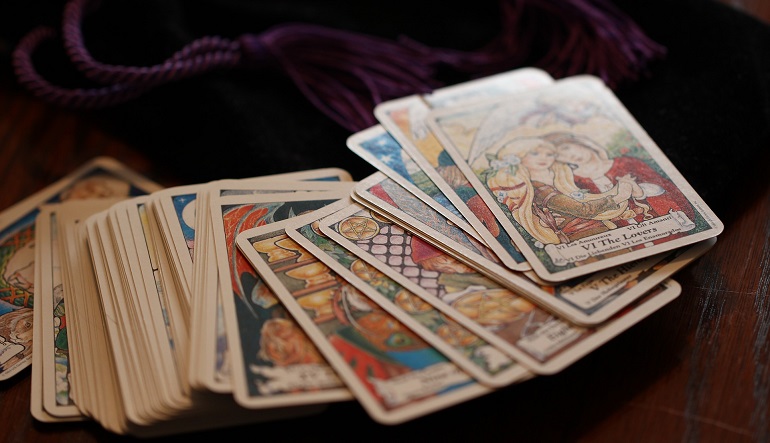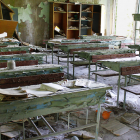Tarot in the Time of Uncertainty
A friend I was visiting a while ago agreed to read tarot cards for me. I was a complete novice in the matter. My friend started out by explaining that this wasn’t about predicting the future or about getting straightforward answers. Yes/no questions didn’t work. The reading was about me picking up each card, describing what I saw, and then having my friend help me articulate my gut reaction to/analysis of the card with its symbolism.
Though there is often a divining element to tarot practice, what took precedence here was the exploration of my own state of mind. It’s not: the card means this, and therefore this will happen to you. Rather: I must treat my state of mind, my current situation, my own self as complex accumulations and representations of everything I’ve experienced, learned, read, seen, heard, integrated over the years. Think of it as a landscape painting, layered with symbolism that cannot always be understood–not because the meaning is too far removed, but because, given everything we’ve experienced, it’s hard to know where to begin. The tarot cards act as a guide–a suggestion as to where to start looking when you don’t even know what you’re looking for, and what to be attentive to.
Because this is the core of the process: attentiveness. Reading a tarot card and immediately superimposing the alleged symbolism onto your life, without paying attention to how the two may not quite fit together, is dangerous because it assumes friction can be overlooked. In the same way, for those of us who make a living by creating and/or critically reading texts, attention is imperative. Once we start looking into a text, we must be attentive to the ways it weaves meaning in and out of the words through structure and sound and a myriad other factors. We must also pay attention to the ways the text might resonate differently for different readers, who know and will pick up on different things–just as you and I may focus on different things when looking at the same tarot card, because we subconsciously pick out what is most relevant to us in our current situation.
A few years ago, I started writing down on small leaflets every poem or prose fragment that had either moved me to tears or to deeper reflection. I kept those inside a box, and every time I felt at a loss, or could feel a panic attack creeping up, or just was in a bit of a slump, I’d open the box and pull a text at random. I’d read the text for reassurance, to calm down and clear my mind, and then I’d go a step further: I’d scour the text for clues about how to act in this situation. What could it teach me about myself, my reactions, and what I needed to be more attentive to?
Even now, I latch onto the words of others, and there seek space to meditate. In addition to a mantra, poems were my early version of reading tarot cards: they exposed the self not as something to be decrypted so as to give a neat answer to a simple question, but as something to be explored and interpreted. As I’m familiarizing myself with tarot, what strikes me most is the number of parallels between the process of reading the cards–at least in my friend’s practice–and that of hermeneutics, defined broadly as the study of written texts and their meaning. Both acknowledge their object–the card, the text–as a complex system of potentially arcane and ambivalent symbols; but both also deal with how this broader system can be articulated with the singular experience of whomever interacts with the cards or the texts, and how that can open up new ways of understanding. Good interpretation doesn’t fix meaning down once and for all; instead it takes into account the many different ways that the cards or the texts are saying all that they’re saying.
The day after the reading, I bought a set of tarot cards. Last night, I found the old box of poems. I pulled out one poem and one card. This was the poem, which muses over what promises to be a perilous journey, yet ends on a hopeful note. The card was Ten of Swords, which points, in a nutshell, to the oft-painful ending to a difficult situation.
A bad, inattentive reading would merely say: this is saying that the end of a conflict is near; there is hope for a new beginning. This is a bad reading because it is, in a way, always true, and thus never completely adequate.
A good, attentive reading would lead you to reflect on the current conflicts in your life. What have you just completed? What are you about to begin? And: what do you find difficult in all of this? What makes you want to go on?
Whether you’re reading cards or a text, you’re always going to end up with more questions than answers. The reading process doesn’t deliver neat, affirmative statements about what you should do, either with the text or with your own life. Reading tarot cards alongside literary texts reminds me constantly of the value of questions that do not merely deconstruct and expose the internal mechanism of something, but strive to build a foundation for critical exploration and deeper understanding.
The first card of the Major Arcana in tarot is the Fool, who figures a leap of faith at the start of a journey. The Fool is us whenever we start reading, even when we’ve read the text a hundred times before. The Fool is a reminder of the unknown, the choices we will have to make, the necessity, as readers and artists and creators of all stripes, of trusting in the journey ahead and in unresolved questions, especially in a world that grows more and more uncertain every day.




